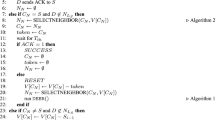Abstract
Mobility causes frequent link failures in ad-hoc networks. This results in a severe degradation of performance specially in case of high mobility of nodes. This is because the routing protocols for ad-hoc networks are not equipped to handle high mobility. In this paper, we have presented a new link management algorithm to locally manage links. This new mechanism is based on signal strength measurements. Researchers over the years have presented approaches which use signal strength measurements but their focus has been on re-active protocols while our algorithm is aimed at pro-active protocols. Pro-active protocols are used since they provide greater flexibility to take advantage of the mesh configuration. We develop the hysteresis mechanism provided by OLSR, based on hello packets, to include signal strength measurements. The mechanism in OLSR uses Hello packets received/lost to decide to establish link or not. The problem with this approach arises when there is high mobility in which case the time to break the link and use a new path becomes significant. To overcome this, we propose to use signal strength to determine if the link-quality is improving or deteriorating. This combination of the two mechanisms, makes the link management more robust and also helps in anticipating link breakages thereby greatly improving performance.
Similar content being viewed by others
Explore related subjects
Discover the latest articles, news and stories from top researchers in related subjects.References
Agarwal, S., Ahuja, A., Singh, J. P., & Shorey, R. (2000). Route-lifetime assessment based routing (RABR) protocol for mobile ad-hoc networks. In Communications, 2000. ICC, 2000 IEEE international conference on (Vol. 3, pp. 1697–1701) New Orleans, LA, USA, 2000.
Akyildiz, I. F., & Wang, X. (2005). A survey on wireless mesh networks. IEEE Communications Magazine, 43(9), S23–S30.
Benzaid, M., Minet, P., & Agha, K. (2002). Integrating fast mobility in the olsr routing protocol.
Clausen, T., & , P.J., (Eds.) (2003). Optimized Link State Routing protocol (OLSR), October 2003. RFC 3626, Experimental.
Crisostomo, S., Sargento, S., Brandao, P., & Prior, R. (2004). Improving AODV with preemptive local route repair. In Wireless ad-hoc networks, 2004 international workshop on (pp. 223–227) May/June 2004.
Dube, R., Rais, C., Wang, K., & Tripathi, S. (1997). Signal stability based adaptive routing (ssa) for ad hoc mobile networks, 1997.
Fall, K., & Editor, K. V. (2005). The ns Manual. UC Berkeley and LBL and USC/ISI and Xerox PARC. http://www.isi.edu/nsnam/ns/ns-documentation.html, January 2005
Gaertner, G., O’Nuallain, E., Butterly, A., Singh, K., & Cahill, V. (2004). 802.11 link quality and its prediction—an experimental study. In PWC (pp. 147–163) 2004.
Goff, T., Abu-Ghazaleh, N. B., Phatak, D. S., & Kahvecioglu, R. (2001). Preemptive routing in ad hoc networks. In Mobile computing and networking (pp. 43–52) 2001.
Hyytia, E., & Virtamo, J. (2007). Random waypoint mobility model in cellular networks. Wireless Networking 13(2), 177–188.
Johnson, D. B. Maltz, D. A. & Hu, Y.-C. (2007). The Dynamic Source Routing protocol for mobile ad hoc networks (DSR), February 2007. RFC 4728, Experimental.
Manoj, B. S., Ananthapadmanabha, R., & Murthy, C. S. R. (2001). Link life based routing protocol for ad hoc wireless networks. In Computer communications and networks, 2001. Proceedings. Tenth international conference on (pp. 573–576) Scottsdale, AZ, USA, 2001.
Perkins, C., Belding-Royer, E., & Das, S. (2003). Ad hoc On-demand Distance Vector (AODV) routing, July 2003. RFC 3561, Experimental.
Raisinghani, V. T., & Iyer, S. (2005). Cross-layer design optimizations in wireless protocol stacks. Computer Communications, 27(8), 720–724.
Ramani, I., & Savage, S. (2005). Syanscan: Practical fast handoff for 802.11 infrastructure networks. In INFOCOM’05. IEEE Communications Society, March 2005.
Samar, P., & Wicker, S. B. (2006). Link dynamics and protocol design in a multihop mobile environment. IEEE Transactions on Mobile Computing, 5(9), 1156–1172.
Toh, C.-K. (1997). Associativity-based routing for ad hoc mobile networks. Wireless Personal Communication, 4(2), 103–139.
Author information
Authors and Affiliations
Corresponding author
Additional information
This work is supported by the French government funded project ANR RNRT R2M (Reseaux Mesh et Mobilite–Mesh networks and mobility).
Rights and permissions
About this article
Cite this article
Ali, H.M., Naimi, A.M., Busson, A. et al. Signal strength based link sensing for mobile ad-hoc networks. Telecommun Syst 42, 201 (2009). https://doi.org/10.1007/s11235-009-9180-y
Published:
DOI: https://doi.org/10.1007/s11235-009-9180-y




